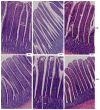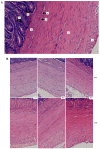Artificial Pasture Grazing System Attenuates Lipopolysaccharide-Induced Gut Barrier Dysfunction, Liver Inflammation, and Metabolic Syndrome by Activating ALP-Dependent Keap1-Nrf2 Pathway
- PMID: 38003191
- PMCID: PMC10668702
- DOI: 10.3390/ani13223574
Artificial Pasture Grazing System Attenuates Lipopolysaccharide-Induced Gut Barrier Dysfunction, Liver Inflammation, and Metabolic Syndrome by Activating ALP-Dependent Keap1-Nrf2 Pathway
Abstract
Geese can naturally obtain dietary fiber from pasture, which has anti-inflammatory and antioxidant properties. This study aimed to investigate the inhibitory impacts of pasture on ameliorating LPS-ROS-induced gut barrier dysfunction and liver inflammation in geese. Materials and methods. The lipopolysaccharides (LPS), alkaline phosphatase (ALP), reactive oxygen species (ROS), tight junction proteins, antioxidant enzymes, immunoglobulins, and metabolic syndrome were determined using ELISA kits. The Kelch-like-ECH-associated protein 1-Nuclear factor erythroid 2-related factor 2 (Keap1-Nrf2) and inflammatory cytokines were determined using the quantitative reverse transcription PCR (RT-qPCR) method. The intestinal morphology was examined using the Hematoxylin and Eosin (H&E) staining method in ileal tissues. Results. Pasture significantly influences nutrient absorption (p < 0.001) by ameliorating LPS and ROS-facilitated ileal permeability (p < 0.05) and systemic inflammation (p < 0.01). Herein, the gut permeability was paralleled by liver inflammation, which was significantly mimicked by ALP-dependent Nrf2 (p < 0.0001) and antioxidant enzyme activation (p < 0.05). Indeed, the correlation analysis of host markers signifies the importance of pasture in augmenting geese's health and production by averting gut and liver inflammation. Conclusions. Our results provide new insight into the mechanism of the pasture-induced ALP-dependent Nrf2 signaling pathway in limiting systemic inflammation in geese.
Keywords: Keap1-Nrf2; geese; intestinal alkaline phosphatase; lipopolysaccharides; pasture grazing; systemic inflammation.
Conflict of interest statement
The authors declare no conflict of interest.
Figures








References
-
- Ali Q., Ma S., Farooq U., Niu J., Li F., Li D., Wang Z., Sun H., Cui Y., Shi Y. Pasture intake protects against commercial diet-induced lipopolysaccharide production facilitated by gut microbiota through activating intestinal alkaline phosphatase enzyme in meat geese. Front. Immunol. 2022;13:1041070. doi: 10.3389/fimmu.2022.1041070. - DOI - PMC - PubMed
Grants and funding
LinkOut - more resources
Full Text Sources
Research Materials

